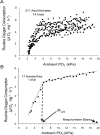Metabolic rate and hypoxia tolerance are affected by group interactions and sex in the fruit fly (Drosophila melanogaster): new data and a literature survey
- PMID: 28202465
- PMCID: PMC5399560
- DOI: 10.1242/bio.023994
Metabolic rate and hypoxia tolerance are affected by group interactions and sex in the fruit fly (Drosophila melanogaster): new data and a literature survey
Abstract
Population density and associated behavioral adjustments are potentially important in regulating physiological performance in many animals. In r-selected species like the fruit fly (Drosophila), where population density rapidly shifts in unpredictable and unstable environments, density-dependent physiological adjustments may aid survival of individuals living in a social environment. Yet, how population density (and associated social behaviors) affects physiological functions like metabolism is poorly understood in insects. Additionally, insects often show marked sexual dimorphism (larger females). Thus, in this study on D. melanogaster, we characterized the effects of fly density and sex on both mass-specific routine oxygen consumption (V̇O2) and hypoxia tolerance (PCrit). Females had significantly lower routine V̇O2 (∼4 µl O2 mg-1 h-1) than males (∼6 µl O2 mg-1 h-1) at an average fly density of 28 flies·respirometer chamber-1 However, V̇O2 was inversely related to fly density in males, with V̇O2 ranging from 4 to 11 µl O2 mg-1 h-1 at a density of 10 and 40 flies·chamber-1, respectively (r2=0.58, P<0.001). Female flies showed a similar but less pronounced effect, with a V̇O2 of 4 and 7 µl O2 mg-1 h-1 at a density of 10 and 40 flies·chamber-1, respectively (r2=0.43, P<0.001). PCrit (∼5.5 to 7.5 kPa) varied significantly with density in male (r2=0.50, P<0.01) but not female (r2=0.02, P>0.5) flies, with higher fly densities having a lower PCrit An extensive survey of the literature on metabolism in fruit flies indicates that not all studies control for, or even report on, fly density and gender, both of which may affect metabolic measurements.
Keywords: Drosophila; Oxygen consumption; Respirometry techniques; Sex; Social interaction.
© 2017. Published by The Company of Biologists Ltd.
Conflict of interest statement
The authors declare no competing or financial interests.
Figures






Similar articles
-
Metabolic function in Drosophila melanogaster in response to hypoxia and pure oxygen.J Exp Biol. 2009 Oct 1;212(19):3132-41. doi: 10.1242/jeb.031179. J Exp Biol. 2009. PMID: 19749106 Free PMC article.
-
EFFECT OF ECTOPARASITIC MITES ON SEXUAL SELECTION IN A SONORAN DESERT FRUIT FLY.Evolution. 1995 Aug;49(4):660-669. doi: 10.1111/j.1558-5646.1995.tb02302.x. Evolution. 1995. PMID: 28565138
-
Sleep in Populations of Drosophila Melanogaster.eNeuro. 2015 Aug 21;2(4):ENEURO.0071-15.2015. doi: 10.1523/ENEURO.0071-15.2015. eCollection 2015 Jul-Aug. eNeuro. 2015. PMID: 26465005 Free PMC article.
-
Feeding and attraction of non-target flies to spinosad-based fruit fly bait.Pest Manag Sci. 2006 Oct;62(10):933-9. doi: 10.1002/ps.1259. Pest Manag Sci. 2006. PMID: 16835891
-
The evolution of Drosophila melanogaster as a model for alcohol research.Annu Rev Neurosci. 2013 Jul 8;36:121-38. doi: 10.1146/annurev-neuro-062012-170256. Epub 2013 Apr 29. Annu Rev Neurosci. 2013. PMID: 23642133 Review.
Cited by
-
Sex and age specific reduction in stress resistance and mitochondrial DNA copy number in Drosophila melanogaster.Sci Rep. 2019 Aug 23;9(1):12305. doi: 10.1038/s41598-019-48752-7. Sci Rep. 2019. PMID: 31444377 Free PMC article.
-
Bugs on Drugs: A Drosophila melanogaster Gut Model to Study In Vivo Antibiotic Tolerance of E. coli.Microorganisms. 2022 Jan 7;10(1):119. doi: 10.3390/microorganisms10010119. Microorganisms. 2022. PMID: 35056568 Free PMC article.
-
Airway specific deregulation of asthma-related serpins impairs tracheal architecture and oxygenation in D. melanogaster.Sci Rep. 2024 Jul 17;14(1):16567. doi: 10.1038/s41598-024-66752-0. Sci Rep. 2024. PMID: 39019933 Free PMC article.
-
Scientific and technical assistance on welfare aspects related to housing and health of cats and dogs in commercial breeding establishments.EFSA J. 2023 Sep 14;21(9):e08213. doi: 10.2903/j.efsa.2023.8213. eCollection 2023 Sep. EFSA J. 2023. PMID: 37719917 Free PMC article.
-
Apple Polyphenol Diet Extends Lifespan, Slows down Mitotic Rate and Reduces Morphometric Parameters in Drosophila Melanogaster: A Comparison between Three Different Apple Cultivars.Antioxidants (Basel). 2022 Oct 22;11(11):2086. doi: 10.3390/antiox11112086. Antioxidants (Basel). 2022. PMID: 36358458 Free PMC article.
References
-
- Baldal E. A., Brakefield P. M. and Zwaan B. J. (2006). Multitrait evolution in lines of Drosophila melanogaster selected for increased starvation resistance: the role of metabolic rate and implications for the evolution of longevity. Evolution 60, 1435-1444. 10.1111/j.0014-3820.2006.tb01222.x - DOI - PubMed
LinkOut - more resources
Full Text Sources
Other Literature Sources
Molecular Biology Databases

